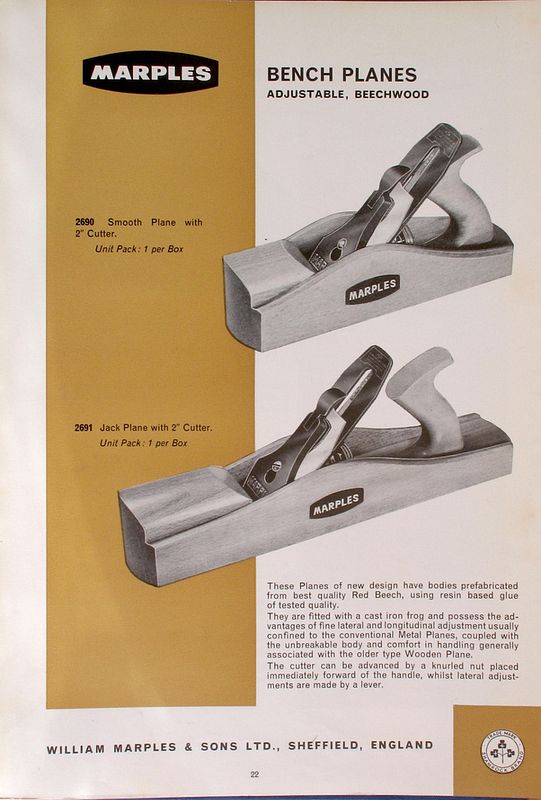
Back in the 1960s, Marples offered a line of 'hybrid' planes. They had a wooden body - built up by gluing blocks between thin outer sides - and a Bailey style adjuster.
Paul Sellers did a recent blog post to introduce a video on how to make one, which seems a good idea if you have a donor plane and some suitable wood around the place.
I don't have a Marples catalogue recent enough to list these planes but I do have a little supplement to The Woodworker in May 1960 which listed the planes then available, from Stanley, Record, Marples and Woden. It showed two models, a 10" smoother, at 32s 6d and a 14" Jack, at 40s. (The equivalent Stanley no 4 was 41s and a no 5 was 49s 9d.)
Both models pop up fairly often on eBay and by studying the pictures of completed lots I think I can list their characteristics:
- The front block sticks up above the sides and is rounded at the top, chamfered behind.
- The sides rise up in a nice curve, like a metal plane.
- The name MARPLES is stamped on the front block.
- A transfer appears on one side.
- The beechwood body is protected with a clear varnish of some sort.
- The metal frog is painted gold.
- The lever cap and iron are marked MARPLES.
At Richard Arnold's bring and buy charity tool sale, there was a ratty old plane which looked like one of these. Actually, it was there last year but nobody wanted it, so I bought it this time round. It looked like this:

I have now cleaned it up and put it back in working condition. In doing so I noticed several things.
The lever cap and iron are both by Stanley, which is no surprise in itself. They fit the frog ok. Both iron and frog are 1 3/4" wide - which is the No 3 size. As far as I know the Marples planes were only offered with a 2" iron, and there is plenty of room for one to be fitted.
The frog is non-standard - it is flat at the bottom with no 'step' and no obvious signs of having been cut down.

- but it is painted gold, like the Marples frogs in their planes.
There is no Marples name marked - I looked carefully before scraping off the old dirt and finish - and there was no trace of any indentation at all.
So what have I got here? The profile looks exactly like a commercial Marples plane. I can see that the design is easy to copy, so if this is a copy it is well done. But would a copier have hit upon a Marples frog or gone to the trouble of painting another one gold?
Could it have been factory made but with the wrong size frog used? That sounds a bit unlikely.
The other big difference is that this plane has a closed handle, while all the others I have seen have a common 'spike' handle.
Does anyone have anything similar to compare, or any other ideas?



































